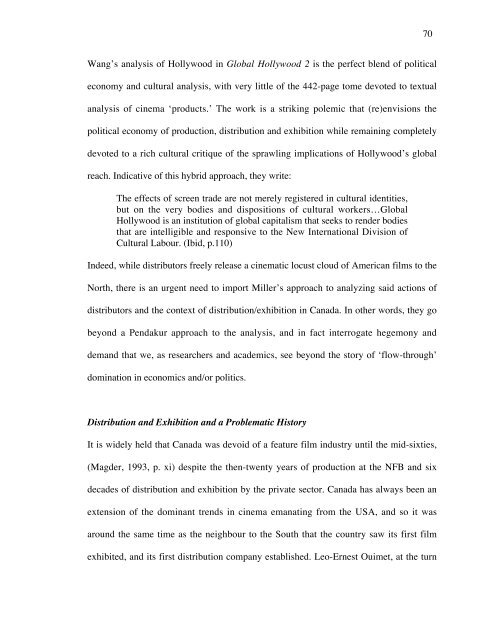The Spaces Between Grassroots Documentary ... - Ezra Winton
The Spaces Between Grassroots Documentary ... - Ezra Winton
The Spaces Between Grassroots Documentary ... - Ezra Winton
Create successful ePaper yourself
Turn your PDF publications into a flip-book with our unique Google optimized e-Paper software.
Wang’s analysis of Hollywood in Global Hollywood 2 is the perfect blend of political<br />
economy and cultural analysis, with very little of the 442-page tome devoted to textual<br />
analysis of cinema ‘products.’ <strong>The</strong> work is a striking polemic that (re)envisions the<br />
political economy of production, distribution and exhibition while remaining completely<br />
devoted to a rich cultural critique of the sprawling implications of Hollywood’s global<br />
reach. Indicative of this hybrid approach, they write:<br />
<strong>The</strong> effects of screen trade are not merely registered in cultural identities,<br />
but on the very bodies and dispositions of cultural workers…Global<br />
Hollywood is an institution of global capitalism that seeks to render bodies<br />
that are intelligible and responsive to the New International Division of<br />
Cultural Labour. (Ibid, p.110)<br />
Indeed, while distributors freely release a cinematic locust cloud of American films to the<br />
North, there is an urgent need to import Miller’s approach to analyzing said actions of<br />
distributors and the context of distribution/exhibition in Canada. In other words, they go<br />
beyond a Pendakur approach to the analysis, and in fact interrogate hegemony and<br />
demand that we, as researchers and academics, see beyond the story of ‘flow-through’<br />
domination in economics and/or politics.<br />
Distribution and Exhibition and a Problematic History<br />
It is widely held that Canada was devoid of a feature film industry until the mid-sixties,<br />
(Magder, 1993, p. xi) despite the then-twenty years of production at the NFB and six<br />
decades of distribution and exhibition by the private sector. Canada has always been an<br />
extension of the dominant trends in cinema emanating from the USA, and so it was<br />
around the same time as the neighbour to the South that the country saw its first film<br />
exhibited, and its first distribution company established. Leo-Ernest Ouimet, at the turn<br />
70


